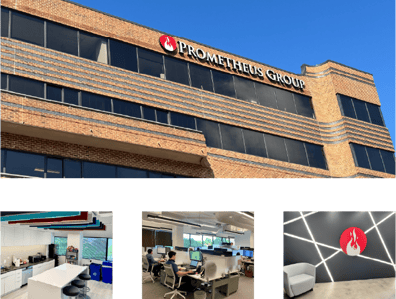You’ve heard of digitization and digital transformation, but what is digitalization? It’s likely that you have been using digitization and digital transformation to describe digitalization all along without even realizing it.
Understanding digitalization in asset management
Asset-intensive industries are under increasing pressure to improve efficiency, reduce costs, and extend the lifespan of critical equipment. To meet these demands, organizations are shifting from manual processes and outdated systems to digital asset management solutions that enhance visibility, automation, and decision-making.
However, the terminology surrounding this shift can be confusing. Digitization, digitalization, and digital transformation are often used interchangeably, despite having distinct meanings. Understanding these differences is crucial for organizations looking to implement the right technologies and strategies.
This article breaks down these key terms, explores the role of digital asset management (DAM), and examines how businesses can leverage digitalization to enhance asset performance, reduce downtime, and drive operational excellence.
The difference between digitization, digitalization, and digital transformation
What is asset digitization?
Digitization can be defined as creating digital versions of previously analog or physical items, laying the foundation for more advanced digital strategies. An example would be creating a digital work order that was previously a paper work order. However, digitization alone does not fundamentally change business processes—it simply makes existing information easier to manage and retrieve. This is the beginning step for an asset management company to go digital.
What is asset digitalization?
Digitalization on the other hand, is the use of digital technologies to change a business model and provide new ways and opportunities of doing business. Examples of asset digitalization:
- Utilizing data from the digital work order you produced via digitization to improve current business processes.
- The use of IoT (Internet of Things) sensors to monitor asset performance in real time.
Digitalization is essentially a transformation within a company that utilizes digital technologies and data to improve the way things are done. By analyzing this data, organizations can implement predictive maintenance strategies, reducing unexpected failures and optimizing maintenance schedules. Digitalization enhances workflows, enabling a more proactive approach to asset management.
What is digital transformation in asset management?
Digital transformation is a more holistic view, in that it not only focuses on digitizing and digitalizing but also focuses on how to implement these changes throughout an organization. It engages the entire company and the people that make up the company, rather than just the processes and the data that are part of the company.
Unlike Digitization and Digital Transformation, Digitalization focuses solely on how ‘going digital’ improves or changes your business processes.
Key takeaways:
- Digitization is about converting analog data into digital formats
- Digitalization involves leveraging digital technologies to enhance business processes
- Digital transformation is a holistic organizational shift that integrates digital tools to drive innovation
What does this mean for asset management?
Asset Management, at its core, is about keeping the asset running to maximize output and minimize the costs associated with downtime and repairs.
There are many different variables that go into asset management such as scheduling, planning, and budgeting. But the goal is to maximize the output of every asset and minimize any losses incurred as a result of downtime, repairs, and replacements.
This is the purpose behind the Digitalization of Asset Management (DAM) – to help transform current business processes to drive profitability.
Digitalization of Asset Management encompasses all elements of the asset management process including the scheduling of work, having ample supplies to complete work, identifying imminent failures, capturing accurate and timely data, and being able to analyze that data as it is computed, as well as down the road, to identify trends and behavioral patterns of the machines.
There are many moving parts and different people that it is essential to be able to connect those parts and people in a centralized hub (or cloud). Many asset-intensive organizations have outdated processes that make the above seem unattainable or at the very least – a massive undertaking. While it’s no easy task, it is possible and the return on investment makes the undertaking worthwhile.
What is digital asset management (DAM)?
Digital asset management (DAM) is a centralized system designed to store, organize, and retrieve digital assets such as images, documents, videos, and operational data. In asset management, DAM plays a critical role by providing seamless access to essential asset-related information, improving efficiency, and reducing operational costs. By consolidating asset data in a structured digital environment, organizations can optimize workflows, enhance decision-making, and ensure consistency across teams.
How DAM enhances asset management:
- Centralized data storage: Organizes digital assets for easy retrieval and analysis
- Real-time asset monitoring: Enables organizations to track asset performance remotely
- Automated workflows: Streamlines asset management processes by reducing manual interventions
- Improved collaboration: Enhances communication between maintenance teams, engineers, and decision-makers
Examples of digital assets in asset management
Digital assets play a crucial role in modern asset management by enhancing visibility, improving decision-making, and streamlining maintenance processes. These assets provide organizations with the data and insights needed to optimize operations, reduce downtime, and extend asset lifespan. Key examples include:
- Work order history: Digital records of past maintenance activities, helping teams make informed decisions
- IoT sensor data: Real-time information on asset conditions, enabling predictive maintenance
- 3D models & digital twins: Virtual representations of physical assets used for simulations and operational planning
- Equipment manuals and documentation: Digitized guides and schematics accessible from a centralized system
- Operational reports and dashboards: Data-driven insights for performance monitoring and optimization
Benefits of digital asset management in asset management
Implementing DAM in asset management provides organizations with greater control, visibility, and efficiency in handling critical assets. By centralizing and automating asset-related data, DAM enhances productivity, improves decision-making, and reduces operational risks. Here’s how organizations benefit from integrating DAM into their asset management strategies:
- Increased efficiency and productivity: By eliminating manual processes, DAM automates asset tracking, reduces paperwork, and streamlines workflows, allowing teams to focus on value-added activities
- Improved decision-making: Advanced analytics and AI-powered insights enable organizations to make data-driven decisions, optimizing asset lifecycles and reducing operational risks
- Enhanced compliance and security: A centralized DAM system ensures regulatory compliance by maintaining accurate records, tracking asset usage, and securing sensitive information through role-based access controls
- Cost reduction and ROI optimization: Predictive maintenance strategies powered by digitalization help prevent costly breakdowns, reduce downtime, and extend asset life, leading to substantial cost savings
- Better collaboration across teams: With cloud-based DAM platforms, teams across different locations can collaborate effectively, ensuring seamless asset monitoring, reporting, and management
What is DAM software and how does it work?
Understanding DAM software
DAM software is a specialized tool that enables organizations to store, retrieve, and manage digital assets efficiently. These platforms integrate with EAM and CMMS systems, providing a comprehensive digital ecosystem.
Key features of DAM software:
- Metadata tagging: Enables quick asset retrieval through smart categorization
- Version control: Ensures accurate tracking of asset modifications and updates
- AI-driven insights: Uses machine learning algorithms to analyze asset performance
- Cloud accessibility: Allows remote access to asset data, improving flexibility and scalability
- Automated workflows: Streamlines approval processes, reducing bottlenecks
How DAM software works in asset management:
1. Data ingestion: Digital assets such as images, documents, and sensor data are uploaded into the DAM system
2. Asset organization: Metadata tagging and indexing allow for structured data storage
3. Workflow automation: Predefined workflows ensure asset-related tasks follow standardized processes
4. Integration with other systems: DAM software connects with CMMS, ERP, and IoT platforms for comprehensive asset visibility
5. Data analysis and reporting: AI-powered analytics generate actionable insights for asset optimization
FAQs on digitalization in asset management
The future of asset management is digital
Digitalization is revolutionizing asset management, enabling organizations to streamline operations, reduce costs, and make data-driven decisions. Whether through digitization, digitalization, or full-scale digital transformation, companies that adopt these strategies will gain a competitive edge in managing their assets more efficiently and proactively.
Investing in a DAM solution is a crucial step toward maximizing asset performance and ensuring long-term business success. However, successful digitalization requires more than just technology—it demands a strategic approach that includes selecting the right tools, training employees, and optimizing processes to drive efficiency and innovation.
Prometheus Group offers powerful, integrated digital solutions designed to help organizations seamlessly transition to a more advanced and effective asset management strategy. Whether you're looking to enhance data accessibility, automate workflows, or implement predictive maintenance, our solutions empower you to make smarter, faster, and more informed asset management decisions.
Ready to take your asset management strategy to the next level? Contact us to discover how Prometheus Group can help you navigate digitalization and drive operational excellence.



